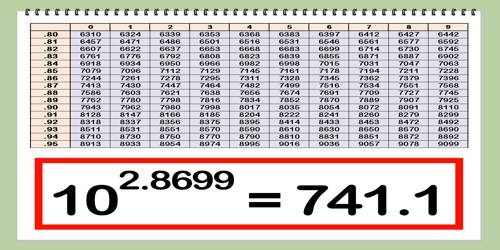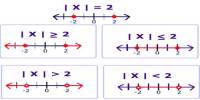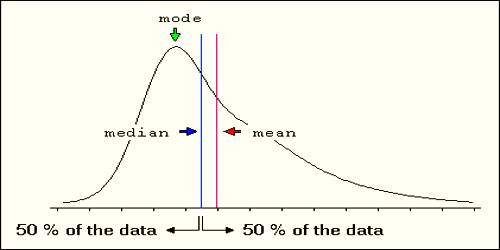In mathematics, logarithms were developed for making complicated calculations simple. In mathematics, the logarithm is the inverse operation to exponentiation, just as division is the inverse of multiplication and vice versa. That means the logarithm of a number is the exponent to which another fixed number, the base, must be raised to produce that number.
Characteristic of the Logarithm – Determination by Mantissa
The characteristic of the logarithm of a number is determined by inspection and the mantissa by the logarithmic table.
(i) To find the characteristic of the logarithm of a number greater than 1:
Since, log 1 = 0 and log 10 = 1, hence the common logarithm of a number between 1 and 10 (i.e., whose integral part consists of one digit only) lies between 0 and 1.
For example, each of the numbers 5, 8.5, 9.64 lies between 1 and 10 (see that the integral part of each of them consists of one digit only); hence their logarithms lie between 0 and 1 i.e.,
log 5 = 0 + a positive decimal part = 0∙ ……
log 8.5 = 0 + a positive decimal part = 0∙ …..
log 9.64 = 0 + a positive decimal part = 0∙ …..
Therefore, the characteristic of each of log 5, log 8.5 or log 9.64 is 0.
Again, the common logarithm of a number whose integral part consists of two digits only (i.e., of a number between 10 and 100) lies between 1 and 2 (log 10 = 1 and log 100 = 2).
For example, the integral part of each of the numbers 36, 86.2, 90.46 consists of two digits; hence their logarithms lie between 1 and 2, i.e.,
log 36 = 1 + a positive decimal part = 1∙ ……
log 86.2 = 1 + a positive decimal part = 1∙ ……
log 90.46 = 1 + a positive decimal part = 1∙ ……
Therefore, the characteristic of each of log 36, log 86.2 or log 90.46 is 1.
Similarly, the characteristic of the logarithm of a number whose integral part consists of 3 digits is 2. In general, the characteristic of the logarithm of a number whose integral part consists of n digits is n – 1. Accordingly, we have the following rule:
The characteristic of the logarithm of a number greater than 1 is positive and is one less than the number of digits in the integral part of the number.
(ii) To find the characteristic of the logarithm of a number lying between 0 and 1:
Since, log .1 = -1 and log 1 = 0, hence the common logarithm of a number between .1 and 1 lies between -1 and 0. For example, each of .5, .62 or .976 lies between .1 and 1; hence their logarithms lie between -1 and 0, i.e.,
log .5 = -0∙ ….. = -1 + a positive decimal part = 1∙ …..
log .62 = -0∙ …. = -1 + a positive decimal part = 1∙ …..
log .976 = -0∙ ….. = – 1 + a positive decimal part = 1∙ …..
[See that a number between (- 1) and 0 is of the form (-0∙ …… ), such as (-0.246),
(-0.594) etc. But (- 0.246) can be expressed as follows:
– 0.246 = -1 + 1 -0.246 = -1 + 0.754 = -1+ a positive decimal part.
It is the convention to represent the mantissa of the logarithm of a number as positive.
For this reason, a number lying between (- 1) and 0 is expressed in the above form.
Again, (-1) + .754 is written as 1.754. Clearly, the integral part in1.754 is negative [i.e., (- 1)] but the decimal part is positive. 1.754 is read as bar 1 point 7, 5, 4. Note that, (-1.754) and (1.754) are not the same. 1.754 = – 1 + .754 but (-1.754) = – 1 – .754]
Therefore, the characteristic of each of log .5, log .62 or log .976 is (- 1).
Again, a number having one zero between the decimal sign and the first significant figure lies between .0l and .1. Hence, its logarithm will lie between (-2) and (- 1) [Since, log .01 = – 2 and log .1 = – 1].
For example, each of .04, .056, .0934 lies between .01 and .1 (see that there is one zero between the decimal sign and the first significant digit in all the numbers) hence, their logarithms will lie between (-2) and (- 1), i.e.,
log .04 = – 1∙ ……. = -2 + a positive decimal part = 2∙ ………….
log .056 = -1∙ ……. = -2 + a positive decimal part = 2∙ …………..
1og.0934= -1∙ ……. = -2 + a positive decimal part = 2∙ …………..
Similarly, the characteristic of the logarithm of a number having two zeroes between the decimal sign and the first significant figure is (- 3). In general, the characteristic of the logarithm of a number having n zeroes between the decimal sign and the first significant figure is – (n + 1).
Accordingly, we have the following rule:
The characteristic of the logarithm of a positive number less than 1 is negative and is numerically greater by 1 than the number of zeroes between the decimal sign and the first significant figure of the number.

(iii) To find the mantissa [using log-table]:
After determining the characteristic of the logarithm of a positive number by inspection, its mantissa is determined by the logarithmic table. At the end of the book, both four-figure and five-figure tables are given. A four-figure table gives the value of mantissa correct to 4 decimal places.
Similarly, a five-figure or a nine-figure log-table gives the value of mantissa correct to five or nine decimal places. Using any one of them we can find the mantissa f the common logarithm of a number lying between 1 to 9999, If the number contains more than 4 significant digits then to find the mantissa by the table either we can approximate it up to 4 significant figures for rough calculations or else we can utilize the principle of proportional parts for more precise calculations. In tables mantissa correct to certain places of decimals are given without the decimal point. It should be remembered that the mantissa of the common logarithm of a number is independent of the position of the decimal point in the number.
http://www.math-only-math.com/common-logarithm-and-natural-logarithm/
















